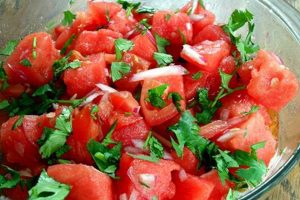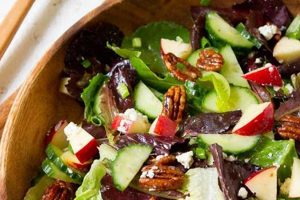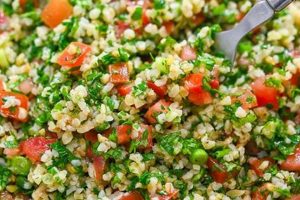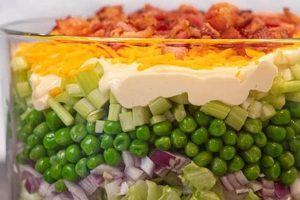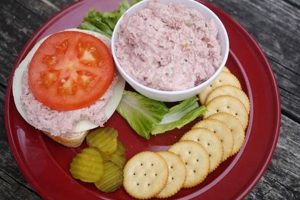This dish presents a modern twist on a classic Middle Eastern parsley salad. Traditional tabbouleh features bulgur wheat as its base, but substituting quinoa offers a complete protein source and a subtly nutty flavor. Typically, finely chopped parsley, mint, tomatoes, cucumber, and red onion are combined with the cooked grain. A simple lemon-and-olive-oil dressing completes the dish. Variations may include other herbs, spices, or vegetables, showcasing the adaptability of this vibrant salad.
The nutritional profile of this grain-based salad makes it a healthful and satisfying meal option. Quinoa provides essential amino acids, fiber, and minerals, while the abundant fresh herbs and vegetables contribute vitamins and antioxidants. This light yet flavorful dish can be enjoyed as a standalone meal, a side dish, or a component of a larger buffet. The historical evolution from bulgur to quinoa reflects the growing awareness of dietary needs and preferences. The adaptation demonstrates culinary creativity while retaining the refreshing essence of the traditional salad.
Exploration of specific ingredients, preparation techniques, variations, and nutritional information will further illuminate the appeal and versatility of this culinary creation. Understanding the cultural context and historical background enhances appreciation for this contemporary adaptation of a beloved classic dish.
Tips for Quinoa Tabbouleh Salad Preparation
Achieving optimal flavor and texture requires attention to key preparation details. These tips offer guidance for a successful culinary experience.
Tip 1: Quinoa Cooking: Rinse quinoa thoroughly before cooking to remove any residual saponins, which can impart a bitter taste. Cook according to package directions, typically using a 2:1 water-to-quinoa ratio. Fluff with a fork after cooking.
Tip 2: Herb Selection: Fresh, high-quality parsley and mint are essential for authentic flavor. Ensure the herbs are vibrant and free of blemishes. Finely chop the herbs to release their aromatic oils.
Tip 3: Vegetable Preparation: Dice vegetables uniformly for even distribution and aesthetic appeal. Seed tomatoes and cucumbers to prevent excess moisture in the salad.
Tip 4: Dressing Emulsification: Whisk together lemon juice, olive oil, salt, and pepper vigorously to create a stable emulsion that evenly coats the salad ingredients.
Tip 5: Flavor Balancing: Adjust the dressing ingredients to achieve the desired balance of acidity, saltiness, and sweetness. Taste and adjust seasonings before serving.
Tip 6: Chilling Time: Allow the salad to chill for at least 30 minutes before serving. This allows the flavors to meld and enhances the refreshing quality of the dish.
Tip 7: Ingredient Customization: Explore variations by incorporating other herbs like dill or cilantro. Add chopped bell peppers, crumbled feta cheese, or toasted nuts for textural and flavor complexity.
Attention to these details ensures a flavorful and well-balanced salad. These culinary guidelines contribute to a satisfying and enjoyable dining experience.
By following these tips, one can create a delicious and nutritious salad that showcases the versatility of quinoa and the vibrant flavors of fresh herbs and vegetables.
1. Ingredients
The essence of a successful quinoa tabbouleh salad lies in the careful selection and balance of its ingredients. Each component contributes to the overall flavor, texture, and nutritional value of the dish. Understanding the role of each ingredient is crucial for creating a harmonious and satisfying culinary experience.
- Base: Quinoa
Quinoa forms the foundation of this modern adaptation. Unlike traditional tabbouleh, which uses bulgur wheat, quinoa offers a complete protein source and a subtly nutty flavor that complements the other ingredients. Rinsing the quinoa before cooking is essential for removing any bitterness from naturally occurring saponins.
- Herbs: Parsley and Mint
Fresh herbs are the heart of tabbouleh. Abundant, finely chopped parsley provides a vibrant, herbaceous flavor, while mint adds a refreshing coolness. The quality and freshness of these herbs significantly impact the final taste. Other herbs, like dill or cilantro, can also be incorporated for variation.
- Vegetables: Tomatoes, Cucumber, and Onion
Finely diced tomatoes contribute juiciness and acidity. Cucumber adds a refreshing crunch and subtle vegetal sweetness. Red onion provides a sharp bite that balances the other flavors. Seeding the tomatoes and cucumbers helps prevent excess moisture in the salad.
- Dressing: Lemon Juice and Olive Oil
A simple vinaigrette of fresh lemon juice and extra virgin olive oil brings the salad together. The lemon juice provides brightness and acidity, while the olive oil adds richness and a smooth mouthfeel. Proper emulsification ensures the dressing evenly coats the salad ingredients.
The interplay of these key ingredients creates a vibrant and balanced salad. The combination of protein-rich quinoa, fresh herbs, crisp vegetables, and a tangy dressing results in a nutritious and flavorful dish suitable for various occasions. The thoughtful selection and preparation of these components elevate the dish beyond a simple salad, transforming it into a culinary expression of freshness and flavor.
2. Preparation
Proper preparation is crucial for a successful quinoa tabbouleh salad. It directly impacts the final taste, texture, and overall quality of the dish. Attention to detail in each stage, from ingredient handling to combining components, ensures a balanced and flavorful outcome. The following facets highlight the essential steps involved.
- Quinoa Cooking
Rinsing the quinoa thoroughly before cooking removes saponins, which can impart a bitter flavor. Cooking the quinoa according to package directions, typically with a 2:1 water-to-quinoa ratio, results in light and fluffy grains. Overcooked quinoa becomes mushy, while undercooked quinoa remains hard and unpleasant. Properly cooked quinoa provides a pleasant, nutty flavor and a light, fluffy texture that complements the other ingredients.
- Herb and Vegetable Processing
Finely chopping the parsley and mint releases their aromatic oils and ensures even distribution throughout the salad. Uniformly dicing the tomatoes, cucumbers, and red onion creates a visually appealing and texturally consistent dish. Seeding the tomatoes and cucumbers prevents excess moisture, which can dilute the flavors and make the salad watery. Precise knife work contributes to both the aesthetic and the palatable qualities of the salad.
- Dressing Emulsification
Whisk together lemon juice, olive oil, salt, and pepper vigorously to create a stable emulsion. A properly emulsified dressing clings to the salad ingredients, distributing the flavors evenly. A poorly emulsified dressing separates, resulting in an uneven flavor distribution and a less appealing presentation. The balance of acidity from the lemon juice and richness from the olive oil is essential for a harmonious flavor profile.
- Combining and Chilling
Gently combine the cooked quinoa, chopped herbs and vegetables, and emulsified dressing in a large bowl. Ensure all ingredients are evenly distributed. Chilling the salad for at least 30 minutes allows the flavors to meld and enhances the refreshing nature of the dish. The chilling period allows the quinoa to absorb the flavors of the dressing and the herbs, resulting in a more cohesive and flavorful salad.
Careful execution of these preparatory steps ensures a well-balanced and flavorful quinoa tabbouleh salad. Attention to detail in each stage contributes to the overall quality of the dish, highlighting the importance of proper preparation in achieving a successful culinary outcome. The combination of correctly cooked quinoa, finely chopped herbs and vegetables, a well-emulsified dressing, and adequate chilling time results in a refreshing, flavorful, and visually appealing salad.
3. Flavor Profile
The flavor profile of a quinoa tabbouleh salad represents a carefully orchestrated balance of contrasting yet complementary tastes and textures. This profile is not accidental; it results from the specific ingredients and their preparation. The nutty, slightly earthy flavor of quinoa provides a neutral backdrop for the more assertive notes of fresh herbs and vegetables. The vibrant, herbaceous character of parsley dominates, punctuated by the cool, refreshing essence of mint. Tomatoes contribute a juicy acidity, balanced by the mild sweetness and crispness of cucumber. Red onion introduces a pungent sharpness, while the lemon-olive oil dressing provides a unifying tang and richness. The interplay of these individual flavors creates a complex and refreshing overall taste experience. For example, omitting the mint would diminish the salad’s cooling element, while reducing the lemon juice might render the dish less vibrant.
This balanced flavor profile offers a significant advantage: broad appeal. The refreshing and light nature of the salad makes it suitable for a variety of palates and occasions. It functions well as a light lunch, a side dish accompanying grilled meats or fish, or a component of a larger buffet. The adaptability of the flavor profile also allows for customization. Adding ingredients like crumbled feta cheese introduces a salty, creamy element, while incorporating chopped bell peppers adds a subtle sweetness and textural variation. Understanding the flavor profile empowers informed choices regarding ingredient adjustments and pairings, optimizing the culinary experience.
Ultimately, the flavor profile of a quinoa tabbouleh salad is key to its appeal. It is a testament to the thoughtful combination of ingredients and the careful execution of preparation techniques. Analyzing the individual contributions of each component allows for a deeper appreciation of the intricate balance achieved. This understanding allows for informed adjustments and pairings, demonstrating the practical significance of flavor profile analysis in creating a successful and enjoyable culinary experience. The careful balance makes it not just a nutritious choice but also a flavorful and refreshing culinary experience.
4. Nutritional Value
Nutritional value represents a significant aspect of a quinoa tabbouleh salad recipe. This value derives primarily from the inherent properties of its components, particularly quinoa, fresh vegetables, and herbs. Quinoa, a complete protein source, provides all nine essential amino acids crucial for muscle building and repair. It also offers a notable amount of dietary fiber, promoting digestive health and satiety. The abundance of fresh parsley, mint, tomatoes, cucumbers, and red onion contributes significant vitamins, minerals, and antioxidants. Parsley, rich in vitamins K and C, supports bone health and immune function. Mint provides antioxidants, potentially aiding digestion. Tomatoes offer lycopene, an antioxidant linked to reduced risk of certain chronic diseases. Cucumbers contribute hydration and electrolytes. Red onion provides quercetin, another antioxidant with potential health benefits. The combined nutritional profile of these ingredients makes the salad a nutrient-dense meal option.
Practical implications of this nutritional density are substantial. Incorporating this salad into a regular diet can contribute to overall health and well-being. For instance, the fiber content can aid in weight management by promoting feelings of fullness, potentially reducing overall calorie intake. The vitamins, minerals, and antioxidants contribute to disease prevention and support optimal bodily functions. Furthermore, the low-calorie nature of the salad, combined with its high nutrient content, makes it a suitable choice for individuals managing weight or seeking to improve their dietary intake. Substituting quinoa for bulgur, as in traditional tabbouleh, elevates the nutritional profile due to quinoa’s complete protein and higher fiber content. This substitution demonstrates how recipe modifications can strategically enhance nutritional value.
In summary, the nutritional value of a quinoa tabbouleh salad offers significant health benefits. Understanding the individual contributions of each ingredient underscores the importance of this dish as a valuable dietary component. Its inclusion in meal planning can support health goals, contribute to disease prevention, and enhance overall well-being. The adaptable nature of the recipe allows for further nutritional enhancement through ingredient variations, showcasing the practicality and significance of nutritional awareness in culinary choices.
5. Cultural Context
Examining the cultural context of a quinoa tabbouleh salad recipe provides valuable insights into its evolution and significance. While tabbouleh’s roots lie firmly within Middle Eastern cuisine, the modern adaptation using quinoa reflects broader culinary trends and cultural exchanges. Understanding this context enhances appreciation for the dish’s origins and its adaptation to contemporary dietary preferences.
- Traditional Tabbouleh
Traditional tabbouleh, originating in the Levant region, features bulgur wheat as its base. It symbolizes freshness and is often served as part of a mezze platter. Parsley is the dominant ingredient, reflecting the region’s abundant use of fresh herbs. The traditional recipe represents a long-standing culinary tradition, emphasizing fresh, locally sourced ingredients.
- Quinoa’s Introduction
The incorporation of quinoa represents a departure from tradition, influenced by global culinary trends and the increasing popularity of ancient grains. Quinoa, originating in the Andes region of South America, offers a nutritional profile that aligns with contemporary health-conscious diets. This adaptation demonstrates culinary fusion and the adoption of ingredients from diverse cultural origins.
- Dietary Adaptations
The use of quinoa also reflects broader dietary shifts. Its gluten-free nature caters to specific dietary restrictions, expanding the accessibility of the dish. The increasing awareness of plant-based diets and the nutritional benefits of quinoa contribute to its adoption as a substitute for bulgur.
- Contemporary Interpretations
Modern interpretations of quinoa tabbouleh often incorporate additional ingredients, reflecting regional variations and individual preferences. These variations demonstrate the adaptability of the dish and its capacity to evolve within different culinary landscapes. The addition of ingredients like dried cranberries, toasted nuts, or different herbs reflects contemporary culinary trends and individual creativity.
Analyzing the cultural context of quinoa tabbouleh demonstrates the dynamic nature of culinary traditions. The dish’s evolution from a bulgur-based salad to a quinoa-based dish illustrates the interplay of cultural exchange, dietary awareness, and culinary innovation. This adaptation, while deviating from tradition, retains the essence of tabbouleh’s refreshing character, demonstrating the enduring appeal of fresh, vibrant flavors across cultures and culinary practices.
6. Variations
The inherent adaptability of a quinoa tabbouleh salad recipe allows for numerous variations, expanding its culinary reach and accommodating diverse preferences. These variations extend beyond simple substitutions and encompass additions, omissions, and adjustments to the core recipe. Such flexibility stems from the salad’s relatively simple structure, allowing modifications without compromising the dish’s fundamental character. Understanding the potential variations provides a deeper appreciation for the recipe’s versatility and practical application in diverse culinary settings. Consider, for example, substituting different herbs. Replacing mint with dill introduces a subtly different flavor profile, appealing to those who prefer dill’s anise-like notes. Similarly, adding chopped bell peppers or crumbled feta cheese alters the texture and flavor, creating a more complex and substantial salad. Such variations exemplify the recipe’s adaptability to individual tastes and ingredient availability.
Further variations highlight the recipe’s potential to accommodate dietary restrictions and preferences. Substituting dried cranberries or chopped apricots for tomatoes offers a lower-acidity, sweeter alternative suitable for individuals with sensitivities. Adding toasted nuts or seeds, such as sunflower or pumpkin seeds, enhances the nutritional value with healthy fats and adds a textural element. For vegan diets, omitting feta cheese or ensuring it is plant-based maintains the dish’s suitability. These examples illustrate the practical application of variations in addressing specific dietary needs without sacrificing flavor or appeal. One might also explore variations in the dressing, perhaps using a lime vinaigrette instead of lemon, or incorporating a touch of maple syrup for sweetness. Such modifications can significantly alter the overall flavor profile, demonstrating the recipe’s responsiveness to creative culinary exploration.
In summary, exploring variations within a quinoa tabbouleh salad recipe underscores its adaptability and relevance across diverse culinary contexts. Understanding the potential modifications empowers cooks to personalize the dish, accommodate dietary needs, and explore creative flavor combinations. The ability to adapt a core recipe demonstrates its practical value and ensures its continued relevance in evolving culinary landscapes. This adaptability ensures the dish remains engaging and accessible, contributing to its enduring appeal.
7. Serving Suggestions
Serving suggestions enhance the versatility of a quinoa tabbouleh salad recipe, demonstrating its adaptability to various culinary contexts. Consideration of these suggestions expands the dish’s potential beyond a standalone salad, integrating it into diverse meal structures and culinary occasions. An understanding of these serving suggestions maximizes the recipe’s practicality and broadens its appeal.
- Light Lunch or Dinner
The salad’s balanced nutritional profile, featuring complete protein from quinoa, fiber, vitamins, and minerals from fresh produce, makes it a suitable standalone light lunch or dinner. Its refreshing nature provides a satisfying yet not overly heavy meal, particularly during warmer months. Serving it with a side of grilled chicken or fish further enhances the meal’s nutritional value and satiety.
- Side Dish
The quinoa tabbouleh salad complements a wide range of main courses, acting as a refreshing counterpoint to richer dishes. It pairs well with grilled meats, roasted vegetables, or fish. Its vibrant flavors and light texture provide a palate-cleansing element, balancing heavier flavors and textures in a meal. For example, serving it alongside grilled lamb provides a textural and flavor contrast, enhancing the dining experience.
- Part of a Mezze Platter
Incorporating the salad into a mezze platter, a selection of small dishes common in Middle Eastern cuisine, aligns with tabbouleh’s traditional role. The salad contributes freshness and a light, herbaceous element to the platter, complementing other traditional dishes like hummus, baba ghanoush, and falafel. This presentation style emphasizes communal dining and shared culinary experiences.
- Packed Lunch or Picnic Item
The salad’s portability makes it a convenient and healthy option for packed lunches or picnics. Its relatively low moisture content compared to traditional leafy green salads contributes to its ability to hold up well over time without becoming soggy. Packing it in a reusable container further emphasizes environmentally conscious meal choices.
These serving suggestions underscore the adaptability and practicality of a quinoa tabbouleh salad recipe within various culinary situations. Understanding these possibilities expands the dish’s utility beyond a single application, demonstrating its value as a versatile and adaptable culinary creation. The various serving options highlight the recipe’s suitability for diverse occasions, dietary preferences, and culinary traditions, contributing to its enduring appeal.
Frequently Asked Questions
This section addresses common inquiries regarding quinoa tabbouleh salad, providing concise and informative responses.
Question 1: Can other grains be substituted for quinoa?
While quinoa offers unique nutritional benefits and a distinct flavor profile, other grains like bulgur (traditional), couscous, or farro can be substituted. However, adjustments to cooking times and water ratios may be necessary. Nutritional content will vary based on the grain selected.
Question 2: How long can the salad be stored?
Properly stored in an airtight container in the refrigerator, the salad typically lasts up to three days. However, the quality of fresh herbs may degrade over time. It is recommended to consume the salad within two days for optimal flavor and texture.
Question 3: Is it necessary to rinse quinoa before cooking?
Rinsing quinoa removes naturally occurring saponins, which can impart a bitter taste. While some pre-rinsed quinoa is available, rinsing is generally recommended to ensure optimal flavor.
Question 4: Can the salad be made ahead of time for large gatherings?
The salad can be prepared a day in advance. Store the quinoa, chopped vegetables, and herbs separately, and combine them with the dressing shortly before serving. This preserves the freshness of the ingredients and prevents the salad from becoming soggy.
Question 5: What are some suitable variations for individuals with dietary restrictions?
Numerous adaptations accommodate dietary needs. For gluten-free diets, ensure all ingredients, including dressings, are certified gluten-free. Vegan variations can replace feta cheese with a plant-based alternative or omit it altogether. Adjustments to sodium content can be made by using low-sodium or no-salt-added ingredients and adjusting seasoning accordingly.
Question 6: Can this salad be frozen?
Freezing is not recommended, as it negatively affects the texture of the fresh vegetables and herbs, resulting in a less palatable dish upon thawing. Freezing also alters the texture of the quinoa, potentially making it mushy.
Addressing these frequently asked questions provides clarity and guidance for preparing and enjoying quinoa tabbouleh salad. Understanding these details ensures optimal results and a positive culinary experience.
Further exploration of recipe variations and serving suggestions can broaden one’s appreciation for this adaptable and nutritious dish.
Conclusion
Exploration of the quinoa tabbouleh salad recipe reveals a dish characterized by nutritional value, culinary adaptability, and cultural significance. From ingredient selection and preparation techniques to flavor profiles and serving suggestions, analysis demonstrates the multifaceted nature of this culinary creation. Nutritional benefits stem from the complete protein in quinoa, complemented by the vitamins and antioxidants present in fresh herbs and vegetables. Adaptability is evident in the numerous variations possible, accommodating diverse dietary needs and preferences. Cultural context reveals the dish’s evolution from traditional bulgur-based tabbouleh, reflecting broader culinary trends and the adoption of ancient grains.
Culinary exploration extends beyond mere sustenance. It delves into the intersection of culture, nutrition, and personal preference. The quinoa tabbouleh salad recipe embodies this intersection, offering a dish that nourishes both body and cultural understanding. Further exploration of culinary traditions and ingredient adaptations promises continued evolution and enrichment of dietary experiences.

